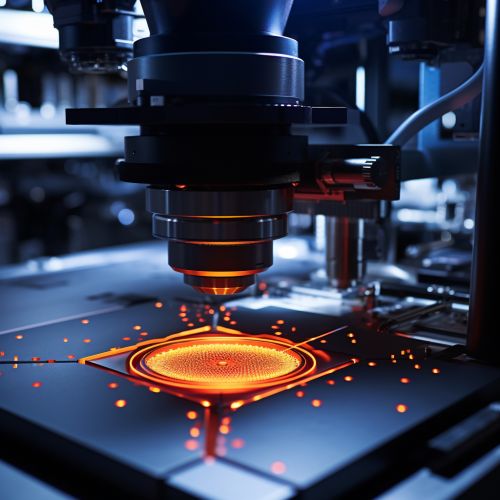Epifluorescence Microscopy
Introduction
Epifluorescence microscopy is a method of fluorescence microscopy that is widely used in life sciences. The technique uses a specific wavelength of light to excite a specimen and then studies the emitted light to gain information about the structure and functioning of the studied material. This method is commonly used in biological and medical research, and has applications in fields such as cell biology, molecular biology, and microbiology more on cell biology, more on molecular biology, more on microbiology.
Principle of Operation
The principle of operation of epifluorescence microscopy involves the use of a specific wavelength of light to excite a fluorescent dye or fluorophore that is bound to the specimen. The fluorophore then emits light of a longer wavelength, which is detected and used to create an image. The excitation light is separated from the emitted light by a dichroic mirror, which reflects the shorter wavelength excitation light and transmits the longer wavelength emitted light.


Components of an Epifluorescence Microscope
An epifluorescence microscope is composed of several key components, including the light source, excitation filter, dichroic mirror, emission filter, and detector. Each of these components plays a critical role in the functioning of the microscope.
Light Source
The light source in an epifluorescence microscope is typically a high-intensity lamp, such as a mercury or xenon arc lamp, or a laser. The light source provides the excitation light that is used to excite the fluorophores in the specimen.
Excitation Filter
The excitation filter is used to select the specific wavelength of light that will be used to excite the fluorophores. This filter only allows light of the desired wavelength to pass through and reach the specimen.
Dichroic Mirror
The dichroic mirror is a key component of an epifluorescence microscope. It reflects the shorter wavelength excitation light towards the specimen and transmits the longer wavelength emitted light towards the detector. This allows the excitation light and emitted light to be separated, which is critical for the functioning of the microscope.
Emission Filter
The emission filter is used to select the specific wavelength of light that will be detected. This filter only allows light of the desired wavelength to pass through and reach the detector.
Detector
The detector in an epifluorescence microscope is typically a camera or photomultiplier tube. The detector captures the emitted light and converts it into an electrical signal, which can then be processed to create an image.
Applications of Epifluorescence Microscopy
Epifluorescence microscopy has a wide range of applications in the life sciences. It is commonly used in biological and medical research, and has been used to study a variety of biological phenomena.
Cell Biology
In cell biology, epifluorescence microscopy is often used to study the structure and function of cells. It can be used to visualize different components of the cell, such as the nucleus, mitochondria, and cytoskeleton, and to study cellular processes such as cell division and cell migration.
Molecular Biology
In molecular biology, epifluorescence microscopy is used to study the interactions between different molecules within a cell. It can be used to visualize the location and movement of specific proteins within the cell, and to study the dynamics of molecular complexes.
Microbiology
In microbiology, epifluorescence microscopy is used to study microorganisms such as bacteria and viruses. It can be used to visualize the structure of these microorganisms, and to study their behavior and interactions with their environment.
Advantages and Limitations
Like any other scientific technique, epifluorescence microscopy has its advantages and limitations.
Advantages
One of the main advantages of epifluorescence microscopy is its ability to visualize specific components of a specimen by using fluorescent dyes or fluorophores. This allows researchers to study the structure and function of these components in great detail. In addition, epifluorescence microscopy allows for the visualization of live cells, which makes it a powerful tool for studying dynamic biological processes.
Limitations
One of the main limitations of epifluorescence microscopy is its limited resolution. Due to the diffraction limit of light, the resolution of epifluorescence microscopy is typically limited to about 200 nanometers. This means that it is not possible to resolve structures that are smaller than this size. Another limitation is the potential for photobleaching and phototoxicity, which can damage the specimen and affect the quality of the images.
See Also
- Confocal Microscopy - Fluorescence Microscopy - Immunofluorescence
